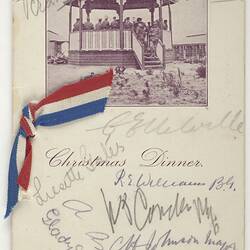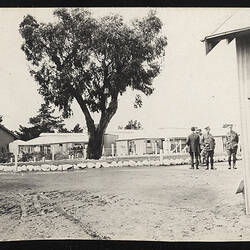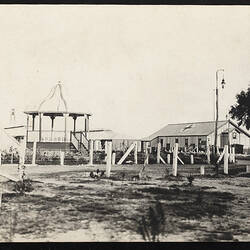Summary
Menu on cardboard for Christmas Dinner, Officers' Mess, Langwarrin, 25 December 1917 at 7pm. The menu includes details of the food eaten and the musical entertainment offered, with an image of the bandstand at Langwarrin Camp on the front, and a soldier with a horse on the back cover. The menu has a number of autographs on the front of people who attended the dinner, including Elsie Storie, amongst whose belongings the menu was found.
The menu belonged to Miss Elsie Storie of Brunswick, later of Canterbury, a young woman during World War I. Amongst her possessions were several photographs of the camp.
The Langwarrin camp area was used during World War I for both 'enemy aliens' and as a hospital for the treatment of soldiers suffering sexually-transmitted diseases.
During World War I, Australian forces during World War I were vulnerable to sexually-transmitted diseases: many on their first adventure away from home, facing an uncertain future or even death, and liberated (at least in part) from the social norms of home. Loss of troop time through STDs during World War I was considered significant: early in 1915, 1000 AIF men were infected at any one time - the equivalent of a battalion at full strength. The official historian of the army in World War I, Arthur Graham Butler, noted that 'in none of the forces from the dominions, serving overseas, far from their homes, of which figures are available, was the proportion of admissions to hospital for venereal treatment less than 100 to every 1000 soldiers.' Returning return to Australia due to sexually-transmitted disease was considered a disgrace. Venereal patients sent home were typically treated at the 'isolation camp' at Langwarrin. By the war's end over 6000 men had passed through the camp.
Physical Description
Menu on cardboard for Christmas Dinner, Officers' Mess, Langwarrin, 25 December 1917 at 7 pm. The menu includes details of the food eaten and the musical entertainment offered, with an image of the bandstand at Langwarrin Camp on the front, and a soldier with a horse on the back cover. The menu has a number of autographs on the front of people who attended the dinner, including Elsie Storie. The menu included oysters, consommé, fish, cutlets, roast duck, steak (chateaubriand Parisien), trifles, plum pudding, sardines, Christmas cake and fruit.
Significance
This material is part of a larger collection of paper-based ephemera that was collected by the donor, Mr Millward, from a rubbish skip at the factory where he worked (the Nicholas Aspro Factory) on its closure several years ago. The material, contained in a box, was part of a deceased estate of Miss Elsie Storie, of Canterbury; it may have been discarded by a director of the factory who had acted as Miss Storie's executor. As a group, the material allows us insight into aspects of the life of a middle-class Melbourne woman who was born c.1895, lived through both wars, and remained in Melbourne all her life.
More Information
-
Collecting Areas
-
Acquisition Information
Donation from Mr John Millward, Mrs Millward, Jun 2005
-
Date of Event
-
Inscriptions
Text: Christmas Dinner/Officers' Mess,/Langwarrin,/7 p.m./25/12/1917.
-
Classification
-
Category
-
Discipline
-
Type of item
-
Overall Dimensions
8.6 cm (Width), 18.4 cm (Height)
-
References
Raden Dunbar, 2014. The Secrets of the Anzacs, Scribe, Melbourne. The menu HT 8455 is depicted on page 201.
-
Keywords
Wars & Conflicts, World War I, 1914-1918, Sexually Transmitted Diseases (STDs), Menus, Food & Catering Industry, Christmas Dinners







